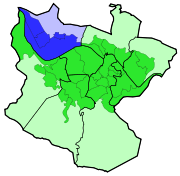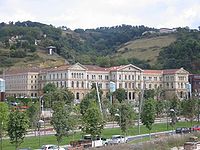
Deusto
Encyclopedia

Bilbao
Bilbao ) is a Spanish municipality, capital of the province of Biscay, in the autonomous community of the Basque Country. With a population of 353,187 , it is the largest city of its autonomous community and the tenth largest in Spain...
, in the Spanish Basque Country
Basque Country (autonomous community)
The Basque Country is an autonomous community of northern Spain. It includes the Basque provinces of Álava, Biscay and Gipuzkoa, also called Historical Territories....
on the right bank of the Estuary of Bilbao
Estuary of Bilbao
The Estuary of Bilbao lies at the common mouth of the rivers Nervion, Ibaizabal and Cadagua, that drain most of Biscay and part of Alava in the Basque Country, Spain. It is a large estuary long that extends from Bilbao to the Bilbao Abra bay, a widening that makes the final transition between...
. It includes the neighbourhoods of San Inazio, Zorrotzaurre, Ibarrekolanda, Elorrieta, Arangoiti and Deusto proper, with a total population of over 52,000. It used to be a separate municipality until it was incorporated in 1925. The traditional center has always been at the Church of St. Peter.
The neighbourhood is linked to downtown Bilbao by a bascule bridge
Bascule bridge
A bascule bridge is a moveable bridge with a counterweight that continuously balances the span, or "leaf," throughout the entire upward swing in providing clearance for boat traffic....
.

University
A university is an institution of higher education and research, which grants academic degrees in a variety of subjects. A university is an organisation that provides both undergraduate education and postgraduate education...
: the University of Deusto
University of Deusto
The University of Deusto is a Spanish Jesuit University, with campuses in Bilbao and San Sebastián, Spain.-History:The University of Deusto first opened in 1886, having been founded because of the Basque Country's desire to have its own university and the Society of Jesus's wish to move its School...
.
In the 1960s the Deusto Canal was excavated, the shore of Deusto was to become an artificial island with facilities for the Port of Bilbao
Port of Bilbao
The Port of Bilbao is located on the Bilbao Abra bay, and along the Estuary of Bilbao, in Biscay . The main facilities are in the Santurtzi and Zierbena municipalities, approximately 15 km west of Bilbao...
. The project was abandoned before its end when it became obvious that bringing more ships to the city would be impractical. The neighbourhood Zorrozaurre
Zorrozaurre
Zorrozaurre is an artificial peninsula located within the Deusto district of Bilbao, Spain. It was formed during the 1950s and the 1960s, when a canal was built to facilitate navigation in the estuary of Bilbao. The project was stopped in 1968 with 400 meters left to finish, forming the current...
then became a separate, artificially created peninsula.
As a rural municipality Deusto produced tomatoes of local renown, and its residents are still nicknamed tomateros.

